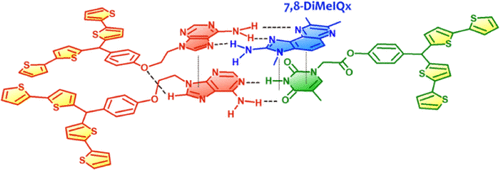Selective Impedimetric Chemosensing of Carcinogenic Heterocyclic Aromatic Amine in Pork by dsDNA-Mimicking Molecularly Imprinted Polymer Film-Coated Electrodes
Ayerdurai V., Carcia-Cruz A., Piechowska J., Cieplak M., Borowicz P., Noworyta K. Spolnik G., Danikiewicz W., Lisowski W., Pietrzyk-Le A., D'Souza F., Kutner W., Sharma P.
J. Agric. Food Chem. 2021, 69, 14689−14698
Abstract
 Inspired by the easy intercalation of quinoxaline heterocyclic aromatic amines (HAAs) in double-stranded DNA (dsDNA), we synthesized a nucleobase-functionalized molecularly imprinted polymer (MIP) as the recognition unit of an impedimetric chemosensor for the selective determination of a 2-amino-3,7,8-trimethyl-3H-imidazo[4,5-f]quinoxaline (7,8-DiMeIQx) HAA. HAAs are generated in meat and fish processed at high temperatures. They are considered to be potent hazardous carcinogens. The MIP film was prepared by potentiodynamic electropolymerization of a pre-polymerization complex of two adenine- and one thymine-substituted bis(2,2′-bithien-5-yl)methane functional monomer molecules with one 7,8-DiMeIQx template molecule, in the presence of the 2,4,5,2′,4′,5′-hexa(thiophene-2-yl)-3,3′-bithiophene cross-linking monomer, in solution. The as-formed MIP chemosensor allowed for the selective impedimetric determination of 7,8-DiMeIQx in the 47 to 400 μM linear dynamic concentration range with a limit of detection of 15.5 μM. The chemosensor was successfully applied for 7,8-DiMeIQx determination in the pork meat extract as a proof of concept.
Inspired by the easy intercalation of quinoxaline heterocyclic aromatic amines (HAAs) in double-stranded DNA (dsDNA), we synthesized a nucleobase-functionalized molecularly imprinted polymer (MIP) as the recognition unit of an impedimetric chemosensor for the selective determination of a 2-amino-3,7,8-trimethyl-3H-imidazo[4,5-f]quinoxaline (7,8-DiMeIQx) HAA. HAAs are generated in meat and fish processed at high temperatures. They are considered to be potent hazardous carcinogens. The MIP film was prepared by potentiodynamic electropolymerization of a pre-polymerization complex of two adenine- and one thymine-substituted bis(2,2′-bithien-5-yl)methane functional monomer molecules with one 7,8-DiMeIQx template molecule, in the presence of the 2,4,5,2′,4′,5′-hexa(thiophene-2-yl)-3,3′-bithiophene cross-linking monomer, in solution. The as-formed MIP chemosensor allowed for the selective impedimetric determination of 7,8-DiMeIQx in the 47 to 400 μM linear dynamic concentration range with a limit of detection of 15.5 μM. The chemosensor was successfully applied for 7,8-DiMeIQx determination in the pork meat extract as a proof of concept.



